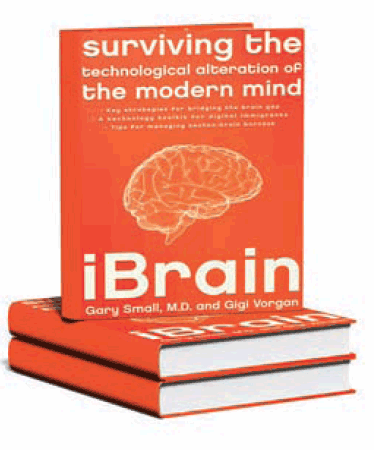iBrain
From this book’s title, iBrain, I expected to learn about the positive impact of the computer world on the ever-evolving brain. I was in for a surprise. iBrain is a nuanced account of brain anatomy and function, brain plasticity, the impact-good and bad-of the Internet and Web access on the brain, and how to have a healthy brain and life in the face of our technological world. The book is written by psychiatrist-neuroscientist Gary Small, MD, director of the Memory and Aging Research Center at UCLA, and his wife, Gigi Vorgan, a film and television actor and writer. Small and Vorgan have a linear, easy-to-understand writing style that includes entertaining and educational case vignettes.
iBrain
by Gary Small and Gigi Vorgan;
New York: Harper Collins, 2008
256 pages • $24.95 (hardcover)
Reviewed by Alexandra N. Helper, MD
From this book’s title, iBrain, I expected to learn about the positive impact of the computer world on the ever-evolving brain. I was in for a surprise. iBrain is a nuanced account of brain anatomy and function, brain plasticity, the impact-good and bad-of the Internet and Web access on the brain, and how to have a healthy brain and life in the face of our technological world. The book is written by psychiatrist-neuroscientist Gary Small, MD, director of the Memory and Aging Research Center at UCLA, and his wife, Gigi Vorgan, a film and television actor and writer. Small and Vorgan have a linear, easy-to-understand writing style that includes entertaining and educational case vignettes.

Most children born after the mid-1980s have grown up with computers. In the parlance of iBrain, these children are “digital natives” while their parents are “digital immigrants.” Functional MRIs reveal that the native’s brain activity is different from that of a person who has not used a computer. Natives are the ultimate multitaskers (using e-mail, Google, YouTube, iTunes, etc, without giving any particular task their complete attention), which is an inevitable downside to intensive computer use.
In the tale of an entrepreneur named Sam, Small and Vorgan show another downside of computer overuse. Sam decides against hiring some talented “techies” to help his business, despite their exciting promotional plans. Why? Because they have lost their people skills. They do not make eye contact with their potential employer. The authors hypothesize that these cyber-hotshots are victims of too much involvement with computers instead of with other humans and go on to point out how too much computer use can impair the ability to be socially capable, compassionate, and empathic.
Another digital pitfall discussed in iBrain is the false sense of intimacy that computer-based relationships may offer users, which is often accompanied by a lessening of ties with actual people in the users’ lives. Too much computer use, expressing itself most severely in computer addictions, may change mood and cognition, leading to irritability and intellectual fogginess. Physical changes accompany computer overuse, such as back and shoulder pain and the difficult-to-treat carpal tunnel syndrome.
Of course, computers can also provide benefits. In a dramatic example of computer-aided medical research, the authors explain how computers are used to reveal how autistic patients interpret the meanings of certain facial expressions. This gives clinicians and scientists information about the autistic brain that may lead to the development of new therapeutic interventions.
Small and Vorgan go on to address more benefits of computers: capacity to access large amounts of information; clinical applications to certain psychiatric disorders and learning disabilities; the chance to complete tasks of daily life, such as banking and contact with medical caregivers; and the efficacy and efficiency of PowerPoint presentations.
After establishing that computers have the capacity to enhance or diminish the richness of life, the authors show us how to maintain a balance in our computer use. They provide scales to help readers determine whether they are already addicted to the computer and quizzes to determine interpersonal competence. Tips are given on how to wean oneself from too much involvement with computers. In iBrain’s world, noncomputer activities, such as meditation and family meals, should not be crowded out by the computer. Exercises for the physical ailments that accompany overuse syndromes are suggested. iBrain lists computer-based information sources that are safe and trustworthy.
As a digital immigrant, I am both in awe of the risks of my entry into the computer world and entranced by how these seemingly magical devices might enhance my world. This relatively short book is like a vein of gold in a mine-an exciting find filled with an enormous lode of valuable and practical information.
